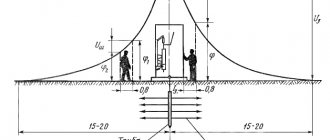Electrical injuries are common threats to humans that exist not only in the workplace, but also in the home. The degree of danger of such injuries is determined by a complex of factors, one of which is the type of electricity.
Therefore, before you start working with electricity, you need to know what danger electric current poses, which current is more dangerous - direct or alternating, and what electrical safety measures to take when working with electrical equipment.
Why is alternating current dangerous?
The peculiarity of alternating voltage is to change polarity with a certain frequency. Accordingly, the direction of electron flow changes with the same frequency. For humans, this type of electric current poses a serious threat, since it has a more pronounced stimulating effect on the nerves and muscles, including the heart.
With electric shocks, the death of victims most often occurs as a result of ventricular fibrillation , which is more likely under the influence of “change”. In addition, alternating current in the electrical network is more dangerous due to the low resistance of the human body in relation to it.
Under certain conditions, alternating voltage is almost completely safe. This is possible with its ultra-high frequency ( more than 20 kHz ). Safety is achieved due to the surface effect, due to which electricity flows only through the skin, affecting its upper layers and not penetrating into the internal organs.
What role does body resistance play?
The resistance of the body depends on the condition of its skin; the following factors can have an influence:
- What condition is a person’s skin in? For example, it can be clean, it can be dirty, wet, damaged.
- What was the area of contact of the current with the skin?
- The magnitude of the applied voltage.
- What frequency current passed through the body.
- General condition of the human nervous system.
If the skin has been scratched or abraded, the dangerous stress may be minimal for death to occur because the body's resistance is reduced. The ability to resist is lost in a person who has a sweaty or dirty hand. For example, a voltage of 30 volts with dry hands does not cause severe pain, but if you touch it with a wet hand, a person will not be able to unclench his fingers and will feel severe pain. In such cases, it is customary to say that a breakdown of skin resistance has occurred.
Why is direct current dangerous?
A constant electric current flows from one pole of the circuit to the other without changing direction. A classic example of this in electrical engineering is powering consumers from batteries.
It is considered less dangerous because when it acts on a person it causes a spasm. The spasm goes away after the tension is relieved, which reduces the likelihood of critical health consequences.
However, we can talk about safety only at low DC voltage values. The higher the voltage, the stronger the danger. At voltages exceeding 500 V, direct current may be more dangerous than alternating current.
A feature of exposure at high voltage is
a stronger knockback effect than at alternating voltage. This can cause a fall and injury with serious health consequences and even death.
Which current is more dangerous and what is the main risk to humans?
Alternating electric current is the most dangerous for humans. It is often fatal because it can provoke ventricular fibrillation of the heart.
However, constant electricity cannot be considered safe either. The consequences of its impact are no less serious, including severe electrical injuries and mechanical injuries when the victim is thrown. difference is that a serious threat arises at high potential values - more than 500 V. People usually do not deal with such voltage in everyday life. However, it occurs quite often in industrial electrical installations.
It must be taken into account that electrical voltage is generally safe for humans. The threat is represented by the effective current generated by this voltage. The degree of threat depends on the value of this value. Thus, alternating current up to 10 milliamps is considered safe.
Serious danger from direct current occurs at amperages greater than 50 milliamps . The mortally dangerous value of electrical alternating current is 90-100 milliamps. At the same values, current and constant voltage are considered fatal to humans.
Factors that affect the body during electric shock
It is necessary to take into account not only the strength of the electric shock, but also what path it will take through the body. It is worth remembering that the longer the current path through the human body, the more severe the consequences will be. As we have already said, alternating current is considered life-threatening; direct current does not have such a destructive effect on the human body. There are a number of additional factors that may increase the danger:
- High current strength.
- Passing it through the body. It should be noted that different tissues of the body have different resistance abilities; in most cases, the current passes through the blood vessels. The worst thing is when the path of the current runs along the entire body, for example, this can happen if the arm and legs are involved, then the current can pass through the heart, spinal cord or brain. But sometimes death can occur when current passes from hand to hand, it all depends on how high the dangerous voltage was.
- Exposure time. The time interval allowed for exposure to current should not exceed 2 seconds.
- Conductivity.
- The area where the electric shock occurs.
It is impossible to calculate exactly how the current will affect the body. Human attention plays an important role, therefore, in dangerous places, it is necessary to provide a special safety sign, which is called the “high voltage” sign.
Dangerous current strength for human life
Electricity can have different effects. With a low electric current, it can be completely unnoticeable or cause only mild discomfort. If this value is amperes , then the effect of the current will be dangerous to the point of death. You can evaluate the consequences of the possible action of each of the two types of electricity with different current strength (amperage) using the table data:
| Current value, mA (milliamps) | The nature of the action of electric current | |
| Constant | Variable | |
| 0.6-1.5 mA | does not appear | mild itching and tingling |
| 2-3 mA | does not appear | slight cramps appear |
| 5-7 mA | minimal skin hyperthermia and mild tingling occurs | cramps intensify, painful sensations appear |
| 8-10 mA | tingling and hyperthermia become more intense | the pain intensifies, the victim is still able to free himself from the action of the current on his own |
| 20-25 mA | in addition to increasing hyperthermia and tingling, minor cramps appear | breathing becomes difficult, paralysis of the limbs occurs, the victim is unable to free himself on his own |
| 50-80 mA | severe hyperthermia of the skin, convulsive muscle contractions, difficulty breathing | arrhythmia appears, paralysis of the respiratory muscles occurs |
| 90-100 mA | paralysis of the respiratory muscles occurs, which can lead to death | Lethal current . At 3 seconds of action, fibrillation of the cardiac ventricles develops, respiratory arrest occurs, salvation is possible only with emergency resuscitation |
These tables clearly demonstrate that alternating electric current is the most dangerous for people.
How much do you need for electrical appliances?
Equipment manufactured in Russia for domestic consumers operates at both 220 V and 230 V, because manufacturers provide the required margin from -15% to +10%. from face value. But in each specific case, the permissible range of power supply characteristics for the device is indicated in the product passport or on its label. For example, computers can operate at 140 - 240 V, and a telephone charger at 110 - 250 V. These markings are often applied to the product itself.
Devices with electric motors are most sensitive to power quality. Here, a reduced voltage can lead to difficulties in starting and shortening the service life of the equipment, while an increased voltage will lead to overloads, which also shorten the service life. If you take a regular incandescent lamp and lower the supply voltage by 10%, the glow intensity will noticeably decrease, and if you increase it, its service life will be reduced by 4 times.
The permissible maximum network limit is 253 V. This value may be too high for electrical equipment designed for 220 volts. The difference in voltage will lead to overheating of power supplies, network adapters, and premature failure of devices.
If you notice that your equipment has begun to overheat or break down, check the voltage in the network. If a deviation of more than 10% is detected, immediately contact your network company. They are required to take measures to eliminate the factors that caused the violations.
Now you know what the voltage standard in the Russian network is according to GOST. If you have any questions, ask comments under the article. We hope the information was useful and interesting for you!
Paths of electric current passing through the human body
The threat is determined not only by the dangerous magnitude of the current, but also by the path of electricity flow through the body. The destructive effect on certain organs depends on this path.
The most dangerous electric current loops
The following pathways are considered the most threatening:
Diagram of the passage of an electric current loop hand - hand
- Hand - hand. Electricity passes through the chest, up to 3.3% of the charge enters the heart.
Diagram of the passage of an electric current loop, right arm - leg
- Right hand - legs. The danger of this loop is associated with the passage of electric current through the heart (about 6.7% of the charge). Also, part of the charge passes through the spinal cord.
Show a diagram of the passage of an electric current loop left arm - legs
- Left hand - legs. Occurs less frequently than the previous loop (usually typical for left-handed people). About 3.7% of the charge affects the heart.
Show a diagram of the passage of an electric current loop leg - leg
- Leg - leg. Characteristic when exposed to step voltage. The heart passes about 0.4% of the charge. The main threat is associated with the possibility of a person falling, as a result of which the value of the step voltage increases, and electricity passes through more dangerous loops.
Show a diagram of the passage of an electric current loop head - legs
- Head - legs. The danger is associated with the effect of electricity on the brain, spinal cord, and spine. 6.8% passes through the heart .
Show a diagram of the passage of an electric current loop head - hands
- Head - hands. One of the most dangerous loops. 7% through itself , and the brain is hit.
What voltage is considered acceptable?
Statistics show that most electrical injuries occur as a result of contact with exposed wires. There are three safe voltages:
- Indoors where there is no greater danger, 65 volts are allowed.
- In a room where there is danger - 36 volts.
- In high-risk areas - 12 volts.
In rooms of the second and third types, there must be a “high voltage” signal that will warn of danger. Employees who, due to the nature of their employment, are forced to work with voltages of up to 1000 V, but neglect safety measures and do not use protective equipment, often fail.
answering the question of what voltage is considered dangerous is quite simple: any electric shock can cause harm, but the most dangerous voltage is considered to be 60 V, when respiratory paralysis and cardiac arrest are possible. But this may not happen if you are attentive to everything that surrounds a person and is at least somehow connected with electricity. Personnel working with high voltage and electric current must always remember safety rules and be in full combat readiness.
So, from this article you learned what voltage is life-threatening. We hope you find this information useful.
What types of electrical injuries exist, protective equipment and first aid
Show flow chart (Types of electric shock)
Electrical burns, depending on the nature of the impact caused to the victim, can be contact and arc. Electrical burns of the first type occur when the body comes into direct contact with a conductor. The degree of burn depends on the duration of such contact and amperage.
There are different degrees of electrical burns:
- The safest injuries are first degree , which affect only the upper layers of the skin and are expressed in its hyperthermia and slight swelling. Recovery takes place without special therapy.
- Second degree skin lesions extend deep into the germ layer . In the area affected by the electric current, blisters filled with a clear liquid form, which should not be punctured. The damaged area may be quite painful. If the affected area is small, the burn goes away without special treatment.
- The third degree is characterized by the death of cells in the inner skin layers , the formation of blisters filled with bloody fluid. Severe redness of the skin is observed in the affected area. In the worst case, it darkens, which indicates tissue necrosis. In this condition, the skin does not regenerate, so the victim requires specialized medical care.
- The most extensive injuries of the fourth degree are associated with burnout of the skin, muscles, and thermal damage to bones. This condition can pose a serious threat to life, so specialized medical care is mandatory.
Electrical marks are specific spots with clear boundaries on the surface of the skin in the area exposed to electric shock. They have a gray or pale yellow tint. The size of such spots is 1-5 mm; there is usually a depression in the center. The shape of the sign can follow the shape of the conductive part, contact with which caused its appearance. The skin in the area of the electric sign hardens. There is no pain or inflammation.
Metallization of the skin is the penetration of molten microscopic particles of conductor metal into its layers. Typically observed when a switch is turned off under load or when attempting to disconnect shorted wires.
Only exposed skin areas are affected, so the main means of preventing metallization is the use of special clothing and protective equipment when working with electrical equipment. During metallization, victims note a sensation of a foreign body and pain at the site of injury. As a rule, metallic skin gradually peels off, and injuries heal without scarring. In the first minutes, it is recommended that the victim apply a sterile bandage.
Electroophthalmia is inflammation of the eyes as a result of ultraviolet radiation from an electric arc. It occurs within 4-8 hours after irradiation of the eyes and is manifested by redness, inflammation, profuse lacrimation, and headache. In severe form, it can lead to loss of vision, so if symptoms develop, you should immediately consult a doctor.
To prevent electrophthalmia, it is necessary to wear safety glasses when working
The listed electrical injuries are local. There are also general electrical injuries , which are characterized by the negative impact of electricity on the entire body. Victims often lose consciousness and develop breathing and heart problems.
The most dangerous phenomenon is ventricular fibrillation, which often ends in death. If the victim of an electric shock is unconscious, he is immediately given cardiopulmonary resuscitation.
With electrical injuries, imaginary death often develops, in which the signs of the body’s vital functions become almost invisible, but the person can be saved. Therefore, cardiopulmonary resuscitation is carried out until the last minute.
First aid to victims of electric current is provided in the following order:
- The victim is released from the effects of electricity . In this case, the person providing assistance must take measures to ensure their own safety.
- Determine the condition of the victim - checking breathing, pulse, etc.
- They free a person from excess clothing, which makes breathing difficult.
- Examine the oral cavity and, if necessary, clean it of vomit, clots of mucus and blood.
- Cardiopulmonary resuscitation measures are initiated.
Show flowchart (Electrical injury at work)
During the provision of assistance, a sufficient supply of fresh air must be ensured in the room and unnecessary people must be removed. Persons who are not directly involved in providing first aid must call doctors and report the incident to the head of the organization (in case of a work-related injury).
You also need to examine the victim for electrical burns and apply a clean, dry bandage to them. After this you need to wait for the doctor. All cases of electrical injuries are subject to hospitalization , even in the absence or removal of dangerous symptoms. This is due to the possibility of developing fibrillation or delayed arrhythmia several hours after the lesion.
Show Flow Diagram (Factors Affecting the Outcome of Electrical Shock)
For a more detailed study of the topic of providing first aid to victims of electric current, we recommend that you familiarize yourself with the methodological material -
Basic norms and rules of electrical safety
The key regulatory documents regulating the field of electrical safety are the following:
- Rules for the construction of electrical installations ( PUE. Edition 7, chapter 1.7 ) –
- Rules for technical operation of consumer electrical installations ( PTEEP ) –
- Rules for labor protection during operation of electrical installations –
- Instructions for the use and testing of protective equipment used in electrical installations -
When performing any work on electrical equipment, the following rules must be observed:
- When designing and installing electrical networks, emergency devices must be used that de-energize the network in the event of a short circuit (short circuit) and in the event of a short circuit to ground. The installation of a ground loop is mandatory.
- Persons with appropriate clearance are allowed to work.
- Special clothing and personal protective equipment required by regulatory requirements must be used.
- It is not allowed to turn on and use equipment and electrical appliances if there is damage to the housing, or to use cables if damage to the insulation is detected.
- It is not allowed to carry out repair work without de-energizing the network.
- Personnel must be able to provide first aid in case of electric shock to a person.
Mandatory voltage regulation in electrical networks
Carrying out your own voltage regulation is not only labor-intensive, but also requires financial investment. An even more difficult option is to seek stabilization of the current in the network from the supplier organization. This can be done by filing complaints, personal appeals, and lawsuits, however, the result is not always achieved even by these methods.
If you still decide to correct the picture yourself, then this is possible in the following way:
- Method of centralized voltage regulation. This approach involves calculating how many changes will be needed to stabilize the situation and adjusting the central power supply accordingly.
- Linear impact method. This is done using a so-called linear regulator, which changes the phases using a secondary winding on the circuit.
- Use of capacitor banks in the network. This method is theoretically called reactive power compensation.
- Also, an extremely unstable network can be corrected using longitudinal compensation. It involves connecting capacitors in series to the network.
Another relevant option, if the deviation from the established norm is not too pronounced, is to install one large or several small stabilizers in the network. This will require some financial investments, special installation skills, and is also not suitable for highly fluctuating power supply systems, because they simply cannot do a large amount of work and regulate a large amount of voltage.
So, as has already been determined, the new generally accepted standard is the network voltage in an apartment from 230 V to 400 V. For example, the voltage scale can be 240 V, 250 V, taking into account the maximum permissible error. However, for the e1f outlet we are used to, the operating voltage is still the same 220V level, which has been familiar to us all since the Soviet period.
How to Avoid Electric Shock
To prevent electric shock to a person, it is necessary to prevent the possibility of bodily contact with live parts and conductors. Therefore, all work is carried out using the necessary protective equipment. The main personal protective equipment of this type include dielectric gloves and boots, dielectric mats and stands, etc.
When working, be sure to use an insulated tool . Personnel are required to undergo training; workers must know how to avoid defeat. Before performing work, be sure to de-energize the corresponding section of the network . In this case, an information sign about the prohibition of turning on the network must be displayed on the switch or circuit breaker. It is not allowed to perform any manipulations with live conductors.
Indicator screwdriver HR28-C (12-250V)
You can check the presence of voltage using special indicator devices. The simplest and most accessible among such devices is an indicator screwdriver.
If there is any doubt whether the conductor is live, you must not work with it!
Video
Watch a video about alternating and direct electric current. These videos will teach you about the hazards and how to protect yourself from electrical shock.
Recommended viewing:
- Question: why can’t I install a duplicate counter?
- Various schemes for crimping twisted pair 4 and 8 cores
- Electromagnetic relay, what is it, what is the principle...
- Surge filters for electrical equipment
- Why didn't the circuit breaker trip? Video
- What is the correct name for a machine for high current...
2+











